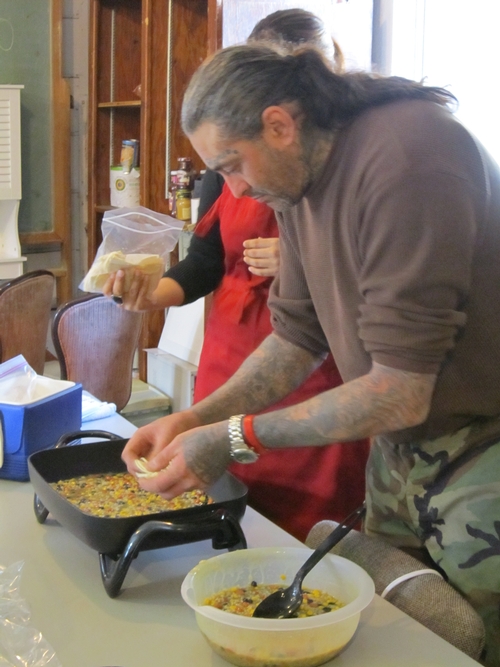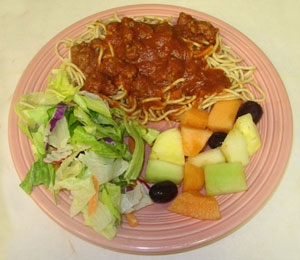Posts Tagged: dietary guidelines
Two key takeaways from new federal dietary guidelines
UC ANR's Nutrition Policy Institute (NPI) has led a push to get the government to make water the drink of choice in the guidelines and add an icon for water on the MyPlate food guide. The guidelines don't go that far, though they do include information that recommends drinking water – in the fine print.
“The guidelines' recommendation to substitute water for sugary drinks is based on solid science. These beverages are the single biggest source of added sugars for our country's kids – and this guidance is explicit and unambiguous and will boost our work in promoting zero-calorie drinking water as the beverage of choice,” said Nutrition Policy Institute Director Lorrene Ritchie. “However, this guidance is presented in a way that gives few Americans an opportunity to see it: on a tip sheet that explains how to use the components of MyPlate ‘to create your own healthy eating solutions — MyWins'. The public health community and the new National Drinking Water Alliance, coordinated through NPI, will build on the potential in this fine-print message by continuing drinking water education, promotion and advocacy.”
The Dietary Guidelines for Americans, updated every five years based on the latest advances in nutritional science, serve as a basis for federal nutrition policy and help set the tone for how Americans should eat. The 2015-2020 guidelines, published this month, recommend a “healthy eating pattern” with limited added sugar and saturated fat, less salt, and more fruits, vegetables and whole grains.
For the first time, the guidelines recommend a clear limit on added sugar of no more than 10 percent of daily calories.
“The science regarding the health risks of a high-sugar diet is strong,” Ritchie said. “Not only is sugar associated with chronic disease risk and obesity, but it also displaces foods known to protect and promote health.”
And what's the simplest way to reduce sugar intake?
“Take a bite out of the added sugars in your diet by drinking plain water instead of sugary beverages,” Ritchie said. “This one simple lifestyle change can be an effective response to the latest nutrition science in the new Dietary Guidelines for Americans.”
Read more UC expert commentary on the new dietary guidelines
An initiative to maintain and enhance healthy families and communities is part of the UC Division of Agriculture and Natural Resources Strategic Vision 2025.
EFNEP helps us eat well on the cheap
Last week (Jan. 31, 2011) the U.S. Department of Agriculture released its revised 2010 Dietary Guidelines for Americans. They are “the federal government's evidence-based nutritional guidance to promote health, reduce the risk of chronic diseases, and reduce the prevalence of overweight and obesity through improved nutrition and physical activity,” according to the press release.
I scanned the press release for news that cookies have been designated an essential food group. No luck. I confess, I didn’t read the entire 95-page pdf, but surely any such rocking revelations would have been reported in the press release.
Because more than one-third of children and more than two-thirds of adults in the United States are overweight or obese, the guidelines emphasize eating less and moving more.
I wasn’t surprised to see among its 23 key recommendations the advice to drink more water instead of sugary drinks, eat a variety of healthy foods and reduce salt. I expected the recommendation to eat more fruits and vegetables, but now it’s more explicit.
They say half of my plate should be covered in fruits and veggies. And mix it up – eat a variety of vegetables and protein sources. (I used to eat broccoli beef almost every day for lunch, until the day I found an insect in it.)
Many people think they have to spend more for nutritious meals, that fresh produce and meat are expensive. However, UC’s Expanded Food and Nutrition Education Program, or EFNEP, gives tips on how to make healthful food choices when you’re on a limited income. (Unless your name is Mark Zuckerberg, whose income isn’t limited?)
Chapter 6 of the Dietary Guidelines acknowledges that our environment – composed of school, workplace, social groups, culture and so on – influences our food and exercise choices. However, our communities don’t excuse our behavior because ultimately we make our own choices, it essentially says. We may have more access to healthy foods and opportunities to engage in physical activity than we realize. Connie Schneider, EFNEP Council chair, sees EFNEP as a vehicle to help families navigate their complicated food environments.
“Our educators facilitate group discussions to resolve food issues from shopping on a budget to getting their children to eat healthier foods,” said Schneider, who is also a UC Cooperative Extension nutrition advisor.
The EFNEP staff meets with families and children in a variety of community settings, including schools, shelters and transitional housing. Nutrition educators teach them how they can stretch their food dollars and still enjoy a healthy diet. They share recipes for nutritious meals that are simple to prepare as well as inexpensive. I love to eat, but have little patience for cooking. Watching a nutrition educator demonstrate how to make chili, I found myself thinking, “That’s so quick and easy, even I would do that.”
Sometimes a new way of preparing a familiar vegetable encourages me to eat more veggies.
The EFNEP website spotlights a Fresh Pick of the Month, such as cauliflower. The site gives the nutritional benefits of cauliflower, serving tips and recommendations for handling and storing the vegetable. It also provides a recipe for cauliflower soup.
The nutrition educators also publish monthly newsletters, in English and Spanish, featuring a recipe and healthful suggestions, such as walking to the restaurant and sharing entrees when you go out to eat. Although the nutrition program is designed to assist families and children whose resources are limited, we can all use the suggestions to improve our health and save some money.

EFNEP enchilada casserole preparation
A new approach in teaching healthy eating
UC Cooperative Extension nutrition educators have discovered that, when it comes to teaching consumers how to eat right, a picture is worth of thousand words.
“We’ve been teaching people for years about MyPyramid and the dietary guidelines, serving sizes and the number of servings they should eat, but many were having a hard time translating that to what exactly to put on their plates,” said Cathi Lamp, the nutrition, family and consumer sciences advisor for Tulare County UCCE.
In an effort to simplify nutrition education, UCCE started with a graphic of a plate, with half designated for fruits and vegetables and a quarter each for protein and grains. However, the concept was still too abstract for concrete thinkers.
“Then we hit upon the idea of photographing familiar foods in the right proportions and showing actual serving sizes arranged on a plate,” Lamp said.
Lamp, and the nutrition, family and consumer sciences advisors for Fresno County, Connie Schneider, and Kern County, Margaret Johns, set out to review 24-hour recall surveys that had been conducted by participants in UCCE nutrition education classes. The 24-hour recall surveys, a mainstay in nutrition research, ask participants to write down everything they have eaten in the previous 24 hours. Each of the advisors focused on recalls from target population groups – Latinos, African-Americans and the general population.
Once they knew what foods people eat, Lamp, Schneider and Johns began the labor-intensive process of preparing and photographing test pictures showing healthy food combinations. Meals included chicken, pizza, spaghetti, sandwiches, tacos, pork chops, fish, stir fry, hamburger, soup and eggs.
Eighteen plates of food were photographed for initial, informal testing. Lamp took the photos to an education session at the local WIC office, where pregnant women and new mothers receive federal nutrition support.
“We handed out a little form and asked the moms if they could identify the foods, whether these were foods they would eat and, if not, what changes they would make,” Lamp said. “The WIC educators loved the images. They could see the value of images of healthy food right off the bat.”
The next step will be cognitive testing of the photos with target clientele, adjustment of the photos based on the results of the testing, retesting the photos in a nutrition education setting and analyzing the results.
Cathi Lamp explains food plate design process.
Feds to suggest Americans eat more plants
New dietary guidelines from USDA and Health and Human Services will recommend even greater reliance on plant-based foods, according to an article in US News & World Report.Every five years, USDA and HHS revise the Dietary Guidelines for Americans; the 2010 version is in development and expected to be released this fall. According to the advisory committee's preliminary report, the new guidelines will encourage Americans to shift food intake patterns to a diet that emphasizes vegetables, cooked dry beans and peas, fruits, whole grains, nuts and seeds.
US News said fruits, vegetables, seeds, beans and nuts get a green light for good reason, but acknowledged that eating more isn't always easy. One approach covered in the article is growing your own.
UC Davis food biochemist Diane Barrett told reporter Megan Johnson that store-bought fruit and vegetables are likely to have traveled many miles over several days. The long journey from farm to table may have allowed nutrients to degrade.
Coordinator of the UC Davis Student Farm, Raoul Adamchak, was also quoted in the US News article. He noted that supermarket tomatoes are frequently picked green - before flavor is fully developed - to help them withstand transport. Also, growers who ship their produce cross-country may favor certain varieties over others not for their taste, but because they travel well.

Homegrown tomatoes can be fully ripened on the vine.


